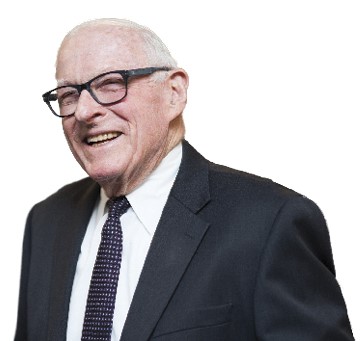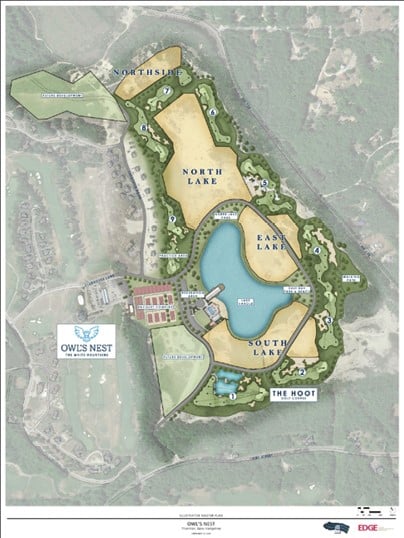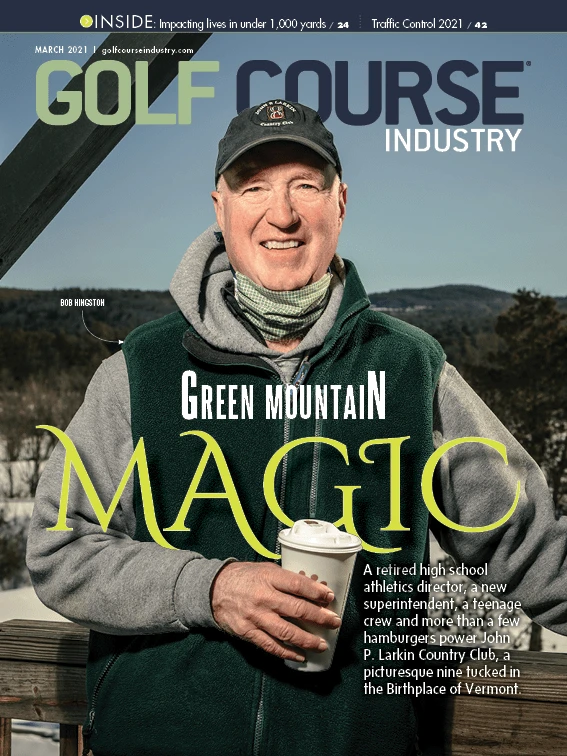
It’s pretty safe to say there has never been a Golf Industry Show like 2021’s virtual offering. Like many, I had no idea what to expect. I should point out I’m not an annual attendee of the show. I usually attend about every third year. Living in western Washington, I tend to hit the show when it’s on or near the West Coast. San Diego is my favorite, don’t-miss site in the rotation. Close, warm and — on a personal note — after the San Diego show ends, I take the Amtrak north to Orange County and visit my sister and her husband for a few days. It’s always a pleasant trip.
Having said that, I had not planned on attending the in-person 2021 event because the 2022 show is set for San Diego. For me, one huge benefit to the 2021 virtual show was that I could participate in an event I wasn’t planning on attending.
So, how was the virtual show? Although I can only give one person’s experience, I’d have to say there was some good, some bad and some so-so. Some of the positives were unexpected, which made them seem even better somehow. And some of the bads were also unexpected — I think this bears out when I say I did not know what to expect of the virtual show — that seemed to make them even more frustrating somehow.
The good
The education sessions were my favorite part of the show. I only purchased the base package, but even with that I found lots of worthwhile and informative sessions offered. Because it was virtual, logistically, I attended more sessions than I normally would have.
I found that attending a session online, either in Zoom or in a webinar, didn’t seem much different than listening to the speakers, watching a PowerPoint presentation and taking notes in person. For the most part, I actually felt like I was in the education session. Even the oddity of having the presenter speaking from their living room or den didn’t seem to diminish the experience.
The bad
For me, the trade show was a bit of an odd experience. Normally, I walk the show floor with a hint of an agenda. But, mainly, it’s not very scripted. I like to wander a bit aimlessly, eventually stumbling on my targeted vendors while finding lots of other stuff on the way. Scrolling through the virtual trade show map just wasn’t the same. Of course, it couldn’t be the same. It was simply bound to be a bit of a weird experience no matter how it was done.
Going into a booth virtually, watching a few videos and perhaps chatting with a rep just didn’t quite get me to where I wanted to be. I think one of the things I like about a normal trade show is eavesdropping. Although I do tend to talk with reps about my specific target needs, I like to listen to someone else getting the lowdown. Piggybacking on someone else’s questions, especially when it’s something I wasn’t actually targeting at the show but did have some level of interest in. That part was missing, so I just hit the things I had targeted, missing out on all that other info I normally get from wandering and eavesdropping.
Another negative for me was that I didn’t give it my full attention, primarily because I wasn’t physically there. In a normal year when I travel to another city and attend the conference, my guess is I’m actually somewhere around 95 percent present at the show. I say 95 percent because most of us remain connected to our courses to a certain level while at the show, usually through our phones. When at the show, I am show focused, first on the education sessions and then the trade show. Aside from checking into work and home a couple times, there are few, if any, distractions.
One mistake I made while attending the virtual show was doing it from work, meaning I invited all kinds of distractions. I thought I could get the crew going in the morning and then devote the rest of my day to GIS. I soon realized that being at work tempts one to … do some work. Because we have a very small crew in the winter, and because our golf course is still unusually busy even in this colder weather because of COVID-19, I couldn’t help but do a little more work on the course than I had planned. I found myself running out to the course numerous times to get something done or check on something and then rushing back to a session. I felt distracted much more than I normally would have.
The so-so
The opening and closing ceremonies were bound to be odd as well and, sure enough, they were. Just like the trade show, there was really no way to do this with any type of normalcy. I attended both sessions only briefly because of the oddity. Again, this was expected, which somehow made it less of a letdown than the trade show.
Networking with our peers is such a big part of the show, whether it’s out in the lobby during the education sessions, on the trade show floor, or having a beer in the hotel bar in the evening or breakfast in the morning. This was sorely missing. But we all knew this going in.
The 2021 show was never going to be a normal experience. The fact that there was a show and those of us who attended felt like we got as much out of it as we possibly could have hoped made it a success at some level. It was a daunting task for those who put the effort into this to make it as good as they could. Hats off to them.
Having said that, I really, really hope I get to take my San Diego trip next February.
Ron Furlong is the superintendent at Avalon Golf Links in Burlington, Washington, and a frequent Golf Course Industry contributor.

Remembering Tony LaFetra
Anthony W. “Tony” LaFetra, president and CEO of Rain Bird Corporation, passed away this winter. During LaFetra’s tenure, the small irrigation company in Glendora, California was built into an international market leader working to promote The Intelligent Use of Water around the world.
LaFetra led the company’s transformation from a manufacturer of brass impact sprinklers, primarily used in agriculture, to a leading provider of irrigation products used worldwide in landscapes, golf courses, sports fields and farms.
LaFetra joined the business in 1964, first serving as a plant manager and later taking on the roles of vice president of sales and marketing, and then executive vice president. In 1978, he succeeded his mother, Rain Bird's co-founder, Mary E. LaFetra, as president and CEO.
His tenure was highlighted by innovations that revolutionized the irrigation industry, from the world's first computerized central control system for irrigation management in the 1970s to the launch of subsurface drip irrigation to save water and reduce the need for herbicides.
LaFetra was an advocate for education. He earned bachelor’s and MBA degrees from Stanford University. He was a lifelong learner and placed high value on the education of Rain Bird employees. Many of them attribute their college educations, advanced degrees and less formal education to the support that Rain Bird provided them over the years.
Outside of Rain Bird, LaFetra sat on the boards of directors of several universities. He most recently sat on the board of trustees at the University of La Verne and he donated generously to establish the LaFetra College of Education.

Tartan Talks No. 56

Robert McNeil designs, restores, renovates and manages golf courses in the Northeast. He even owns one. He’s also a terrific podcast guest.
McNeil’s appearance on the Tartan Talks podcast resembled the type of golf he tries to promote: fast-paced and flexible. Topics ranged from how learning the game at charming Donald Ross-designed Whitinsville Golf Club in Whitinsville, Massachusetts, shaped his future work to his experiences owning Kings Crossing Golf Club in North Kingstown, Rhode Island. Whitinsville and Kings Crossing, coincidentally, are 9-hole courses.
McNeil purchased Kings Crossing, which is just eight miles from his Rhode Island home in 2014. Last year proved good for business as Kings Crossing experienced a 20 percent increase in play, according to McNeil.
“Most courses did very well as far as rounds go and as well as introducing new players to the game,” he says. “The key is how you hold onto those players and what percentage stay in the game.”
McNeil has plenty of retention ideas and some of those concepts are illustrated in his short-course work at The Reserve and The Links at Mendham. His list of current projects includes “The Hoot,” a 9-hole short course at Owl’s Nest Resort in New Hampshire. In addition to working on condensed courses, McNeil has received opportunities to restore Ross, the architect whose work he grew up playing every summer day at Whitinsville.
“It’s an honor and it’s a fun thing to watch,” McNeil says. “When you have a little dream when you’re 14 years old and it comes out to happen the way you kind of envisioned, what else can you ask for?”
Visit the Superintendent Radio Network page on Apple Podcasts, Spotify and other popular podcast distribution services to hear the entire conversation.
Course news
San Vicente Golf Resort in Ramona, California, completed a comprehensive renovation plan that upgrades the golf experience while dramatically improving long-term sustainability of the original 1972 Ted Robinson design. Andy Staples, ASGCA, directed the plan to fully renovate all greens, bunkers and tee complexes to increase strategy and provide a unique style and aesthetic to the San Diego golf market. The project allowed longtime superintendent Pat Shannon to complete a needed renovation prior to his retirement. Australian-born Ben McBride has been named Shannon’s replacement.
Sterling Grove Golf & Country Club, a new semi-private club in Surprise, Arizona, opened for preview play last month. The 18-hole Nicklaus Design golf course is the first new course to open for public play in Arizona since 2016. Set against the backdrop of the White Tank Mountains, the course showcases features from Golden Age architecture. As the course matures, more than 1,700 trees will grow to line fairways and further define the routing. The Sterling Grove course will ultimately become part of a private club.
Toro and Pebble Beach Resorts finalized an agreement naming Toro as the official supplier of golf course maintenance equipment for the resort’s collection of golf courses, which includes Pebble Beach Golf Links, Spyglass Hill Golf Course, The Links at Spanish Bay and Del Monte Golf Course.
Escalante Golf acquired The International in Bolton, Massachusetts — the only 36-hole private golf club in the Greater Boston area. The club includes courses designed by Robert Trent Jones Sr. and Tom Fazio.
Heritage Golf Group announced the purchase of the Shackamaxon Country Club, a century-old private club in Union County, New Jersey, with an A.W. Tillinghast-designed course. Shackamaxon is the ninth property to join the Heritage Golf Group portfolio.
Industry buzz
The Musser International Turfgrass Foundation selected Cameron M. Stephens as the 2021 Award of Excellence recipient. Stephens earned a Ph.D. in plant pathology at NC State, where he pursued a dissertation entitled, “Etiology, Epidemiology, and Management of Take-all Root Rot on Golf Course Putting Greens.” He has already accepted a position as the technical market manager for Turf & Ornamentals for BASF in Research Triangle Park, North Carolina.
FMC announced an exclusive supply agreement with Nisso America to market and sell Picarbutrazox fungicide for use in the golf market. Picarbutrazox is a new mode of action fungicide for control of Pythium diseases. EPA registration is anticipated in 2021 and FMC expects to formally launch the product in early 2022.
John Deere agreed for its golf and sports dealer network to sell and support the Wiedenmann Corporation line of aeration solutions. Through the agreement, customers can purchase Wiedenmann products at John Deere dealers.
Mark F. Jordan, CGCS and natural resource leader at Westfield Country Club in Westfield Center, Ohio, was elected to a one-year term as president of GCSAA at the association’s annual meeting Feb. 4. He is the 85th president in the association’s history. A 34-year GCSAA member, Jordan is also a member and past president of the Northern Ohio GCSA.
Toro acquired TURFLYNX, a privately held developer of autonomous mowing equipment for golf courses. The new Toro employees will continue to be based in Portugal. TURFLYNX is recognized for introducing the industry’s first fully autonomous, all-electric fairway mower in 2016.
The USGA announced LPGA Commissioner Mike Whan will join the organization this summer as CEO. He will become the eighth top executive in USGA history and replaces Mike Davis, who will depart later this year to team with Tom Fazio II in a new course design venture.
More than 9,300 attendees participated in the virtual Golf Industry Show, according to numbers released by the GCSAA. The education component of the event included 88 sessions, and more than 200 exhibitors participated in the trade show.

Explore the March 2021 Issue
Check out more from this issue and find your next story to read.